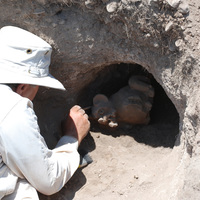Papers by daniela stoyanova
Archaeopress Publishing Ltd eBooks, Dec 20, 2023
Archaeopress Publishing Ltd eBooks, May 20, 2021
The Early Hellenistic Caryatids Tomb, discovered in NE Bulgaria, is a product of highly trained a... more The Early Hellenistic Caryatids Tomb, discovered in NE Bulgaria, is a product of highly trained architects and masons, experienced in all the stages of stone processing. Newly-discovered tombs and masoned graves in the necropoleis of the Getic capital confirm the idea of the workshops' potential, provoking a search for the stone quarries, the location of which was later established by geological surveys. Archaeological investigations of the city revealed new evidence of stonecutting and masonry techniques both in the capital and the tombs. Ruins of huge fortification walls, monumental gates and additional fortifications, as well elements of buildings inside the city were unearthed, which indicate that the building of the city involved the mobilization of considerable material, human and technical resources
Известия на Регионален Исторически Музей-Благоевград, том XVI, Благоевград, 2018, 17-24., 2018
Българско е-Списание за Археология, 2014
Peoples in the Black Sea Region from the Archaic to the Roman Period, 2021
Please contact the authors for a complete .pdf
Environment and Habitation around the Ancient Black Sea, 2021
Please contact the authors for a complete .pdf
Рецензия на М. Русева, Методика за научно изследване на тракийската архитектура. Анализи, тълкува... more Рецензия на М. Русева, Методика за научно изследване на тракийската архитектура. Анализи, тълкуване, символика, София, 2013, 182 стр.

M. Manoledakis (ed.). Peoples in the Black Sea Region from the Archaic to the Roman Period, 2021
The paper discusses the available evidence, written and archaeological, of Macedonian presence al... more The paper discusses the available evidence, written and archaeological, of Macedonian presence along the Black Sea coast from the Thracian conquests of Philip II to the death of Lysimachus (c. 342-281 BC). The review of the scarce written sources reveals a more evenly spread data for the time of Philip and Alexander III, while all mentions for Lysimachus' reign are concentrated to the north of the Balkan Range. Odessos, Kallatis, and Istros took part in the rebellion in 313 BC, Odessos was a major base of Lysimachus by the end of the century, used by Pleistarchus in 302 BC, and the Diadoch had a 'treasury' at nearby Tirizis. Archaeological evidence create a similar picture. For example, inscribed lead sling bullets that could be related to Philip II and the governors of Alexander III (Alexander of Lyncestis and Zopyrion) have been found from Apollonia to the south to the Danube in the north. Barrel-vaulted ('Macedonian') tombs are known only from the necropoleis of Odessos and Kallatis, indicating the presence of high-ranking Macedonians, and the region from Istros to Odessos (and Mesambria) shared the same trends in the architectural decoration in the first decades of the 3rd century BC. The latter are illustrated by the bucrania with garlands that suggest a connection with Samothrace (where Lysimachus was active) and correlate well with the evidence of the cult of the Great Gods of Samothrace that comes only from the region to the north of the Balkan Range. Meanwhile, a strong impression emerges that Apollonia and possibly Mesambria were not part of Lysimachus' domain, which would appear strange having in mind that the region of the Burgas Bay was crucial for the communications between the area to the north and the core of Lysimachus' kingdom in Southeastern Thrace. A hypothetical explanation could be sought for in certain agreements between him and the Thracians to the south of the Balkan Range-one, but not necessarily the only candidate would be Seuthes III.

H. Kaba, G. Kan Şahin, B. M. Akarsu, O. Bozoğlan (eds). “Ancient Sinope and the Black Sea”. International Symposium on Sinope and Black Sea Archaeology, Proceedings Book. Sinop, 2019
Summarizing publications on the architectural terracotta and palmette antefixes in particular alr... more Summarizing publications on the architectural terracotta and palmette antefixes in particular already exist for four of the well known Greek colonies in the Black Sea – Sinope, Mesambria, Olbia, and Istros. Recent archaeological investigations in Apollonia Pontica, both on the peninsula and in the temenos on the offshore island of Sts. Kirik and Julita, uncovered new evidence that enriches the information about the types, the chronology, and the distribution of palmette antefixes in the Black Sea area from Late Archaic to Hellenistic times. The paper presents these new finds and complements them with related evidence of eaves tiles from Apollonia Pontica, when available. In addition, it offers an overview of the distribution, the types, and the production of palmette antefixes in the Black Sea, as well as of the use of palmette types on other elements of the roofing construction.
Вълчев, И. (съст.) Stephanos Archaeologicos ad 80 annum professoris Ludmili Getov. Studia Archaeologica Universitatis Serdicensis, Suppl. VI, 2018
In: Stoyanova, D., Boykov, Gr., Lozanov, I. eds. Cities in Southeastern Thrace, Sofia, 2017

Известия на Регионален Исторически Музей-Благоевград, том XVI, Благоевград, 2018, 17-24., 2018
A Tombstone or a False Stone Door of a Tomb from Heraclea Sintica
In the lapidarium of the Arch... more A Tombstone or a False Stone Door of a Tomb from Heraclea Sintica
In the lapidarium of the Archaeological Museum in Sandanski is kept a stone monument found as a result of illicit digging in the region of the village of Rupite, Petrich municipality, where the remains of the Hellenistic and Roman town of Heraclea Sintica, including its necropoleis, have been identified. Due to this reason no data regarding its exact findspot is available. The monument presents a rectangular plate on whose upper surface are rendered in relief four rectangular cassettes. The field of each cassette is framed with a leaf ornament, whereas in the center of each field a different image is sculpted. In the two upper fields there is a seven-leaf rosette in two registers and an eagle, whereas in the two lower fields there is a seven-leaf rosette in one register and a theatrical mask. Each of the three vertical and horizontal bands shaping the cassettes has a different width. The back, side, lower and upper surfaces are crudely made. The decorative scheme on the front side features a two-leaf stone door. This offers two different interpretations: the monument is a door-stopper, closing a tomb’s entrance or a stela decorated with a two-leaf door. The tombstones decorated with stone doors, in different variants, were widespread during the Roman period. Similarly, however, stone doors, functional or decorative, upon which the same scheme with a two-leaf door with four cassettes continued to be produced. Although the monument under discussion lacks a primary archaeological context and a secure interpretation, the present decorative elements – the leaf ornament, the eagle and the theatrical mask determine its chronology within the 2nd-3rd c. AD.

Даниела Стоянова (София) настоящата статия има за цел да представи общ поглед върху упо требата ... more Даниела Стоянова (София) настоящата статия има за цел да представи общ поглед върху упо требата на строителна керамика и архитектурна теракота в одесос в предримската епоха. Разгледаните материали са основно от елинис тическата епоха. на този етап от проучванията на античния одесос липсва конкретна информация за употреба на строителна керамика преди елинистическата епоха, но данните от другите центрове по западния бряг на Черно море – истрия 1 , аполония 2 и Месамбрия 3 , подсказват, че няма основания да се съмняваме, че има употреба и в поранно време 4. още повече че от одесос са налице сигурни данни за монументални архитектурни сгради, които изискват покритие от керемиди 5. І. характериСтика на обектите, от които е изСледвана Строителна керамика и архитектурна теракота Разглежданият материал произхожда основно от два обекта: от спасителни археологически разкопки на обект в Повеляново (днес квартал на Девня), проучен през 1970 г. 6 , и от спасителни проучвания на ул. " Цар иван Шишман " във варна 7 през 1985–1989 г. Цялостните резултати от посочените обекти не са публикувани. При строителството на теЦ " Девня " се попада на останки от ели нистически обект. Строителната керамика произхожда от комплекс, състоящ се от три помещения, стените на които са изградени от ка менен цокъл от добре обработени варовикови блокове, над който следват кирпичи и покрив от керемиди. Сградата е унищожена от силен пожар, което е довело до запазване на кирпичите и се е отра зило върху състоянието на керемидите. Покривът на сградата е доку ментиран паднал върху нея. във фонда на археологическия музей във варна се съхраняват осем фрагмента от коринтски плоски кере миди с печат и още няколко характерни фрагмента от плоски и покри ващи керемиди. наличните данни са достатъчни, за да може да се











Uploads
Papers by daniela stoyanova
In the lapidarium of the Archaeological Museum in Sandanski is kept a stone monument found as a result of illicit digging in the region of the village of Rupite, Petrich municipality, where the remains of the Hellenistic and Roman town of Heraclea Sintica, including its necropoleis, have been identified. Due to this reason no data regarding its exact findspot is available. The monument presents a rectangular plate on whose upper surface are rendered in relief four rectangular cassettes. The field of each cassette is framed with a leaf ornament, whereas in the center of each field a different image is sculpted. In the two upper fields there is a seven-leaf rosette in two registers and an eagle, whereas in the two lower fields there is a seven-leaf rosette in one register and a theatrical mask. Each of the three vertical and horizontal bands shaping the cassettes has a different width. The back, side, lower and upper surfaces are crudely made. The decorative scheme on the front side features a two-leaf stone door. This offers two different interpretations: the monument is a door-stopper, closing a tomb’s entrance or a stela decorated with a two-leaf door. The tombstones decorated with stone doors, in different variants, were widespread during the Roman period. Similarly, however, stone doors, functional or decorative, upon which the same scheme with a two-leaf door with four cassettes continued to be produced. Although the monument under discussion lacks a primary archaeological context and a secure interpretation, the present decorative elements – the leaf ornament, the eagle and the theatrical mask determine its chronology within the 2nd-3rd c. AD.
In the lapidarium of the Archaeological Museum in Sandanski is kept a stone monument found as a result of illicit digging in the region of the village of Rupite, Petrich municipality, where the remains of the Hellenistic and Roman town of Heraclea Sintica, including its necropoleis, have been identified. Due to this reason no data regarding its exact findspot is available. The monument presents a rectangular plate on whose upper surface are rendered in relief four rectangular cassettes. The field of each cassette is framed with a leaf ornament, whereas in the center of each field a different image is sculpted. In the two upper fields there is a seven-leaf rosette in two registers and an eagle, whereas in the two lower fields there is a seven-leaf rosette in one register and a theatrical mask. Each of the three vertical and horizontal bands shaping the cassettes has a different width. The back, side, lower and upper surfaces are crudely made. The decorative scheme on the front side features a two-leaf stone door. This offers two different interpretations: the monument is a door-stopper, closing a tomb’s entrance or a stela decorated with a two-leaf door. The tombstones decorated with stone doors, in different variants, were widespread during the Roman period. Similarly, however, stone doors, functional or decorative, upon which the same scheme with a two-leaf door with four cassettes continued to be produced. Although the monument under discussion lacks a primary archaeological context and a secure interpretation, the present decorative elements – the leaf ornament, the eagle and the theatrical mask determine its chronology within the 2nd-3rd c. AD.